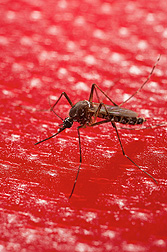Breadfruit: Not So Appetizing to Mosquitoes
A tropical food that’s being hailed by many as a possible solution to world hunger also contains compounds that could help prevent mosquitoes from spreading serious and deadly diseases such as malaria, yellow fever, and dengue fever.
Breadfruit, Artocarpus altilis, is a tropical staple food crop traditionally cultivated for more than 3,000 years throughout Oceania—Melanesia, Micronesia, and Polynesia. The fruit is plentiful, starchy, and packed with nutrients. In addition to being a valuable, nutritious food, breadfruit is used in Hawaii and other regions to control insects. People burn dried clusters of flowers—technically known as “male inflorescences”—to repel flying insects, including mosquitoes.
Scientists from the Agricultural Research Service and Canada’s University of British Columbia teamed together to identify the natural chemicals in breadfruit that deter insects.
“We found that three chemicals—capric, undecanoic, and lauric acids—were responsible for the repellent activity,” says Charles Cantrell, a chemist at the ARS Natural Products Utilization Research Unit (NPURU) in Oxford, Mississippi. “These chemicals are also known as C10, C11, and C12 saturated fatty acids.”
Male inflorescences from a diverse selection of breadfruit trees were sun dried at the National Tropical Botanical Garden’s Breadfruit Institute in Kalaheo, Hawaii, and provided to scientists for testing. ARS scientists collected smoke samples as they burned the inflorescences in the traditional method used in Pacific regions. More than 30 compounds in the smoke were identified, including a mixture of terpenes, aldehydes, fatty acids, and aromatics.
At the ARS Invasive Insect Biocontrol and Behavior Laboratory in Beltsville, Maryland, chemist Kamal Chauhan tested the compounds’ effectiveness against adult Aedes aegypti female mosquitoes in a blood-feeding membrane system that mosquitoes feed upon as if it were a human.
“These natural chemicals were significantly more effective at repelling mosquitoes than DEET, the primary insecticide against biting insects,” Chauhan says. “In regions where they’re available, dried clusters of breadfruit flowers can be used by people who may not be able to afford expensive repellent products.”
“This was the first research to show that breadfruit really works as a repellent, validating a folk remedy,” Cantrell says.
In a separate study, NPURU scientists looked at a wide range of saturated and unsaturated fatty acids and discovered similar results. “These same three chemicals found in breadfruit and other folk remedies were highly active and the most repellent fatty acids that we’ve seen,” Cantrell says.
Chemist Uli Bernier, in the Mosquito and Fly Research Unit at the Center for Medical, Agricultural, and Veterinary Entomology in Gainesville, Florida, used a standard repellency test to evaluate the compounds against mosquitoes. The test uses volunteers who wear cloth treated with various concentrations of the chemicals. Bernier verified that the saturated fatty acids provide effective protection.
These studies were partially funded by the Deployed War-Fighter Protection Research Program, which develops and improves methods to protect U.S. military personnel from disease-transmitting insects.—By Sandra Avant, Agricultural Research Service Information Staff.
This research is part of Veterinary, Medical, and Urban Entomology, an ARS national program (#104) described at www.nps.ars.usda.gov.
To reach scientists mentioned in this article, contact Sandra Avant, USDA-ARS Information Staff, 5601 Sunnyside Ave., Beltsville, MD 20705-5128; (301) 504-1627.
"Breadfruit: Not So Appetizing to Mosquitoes" was published in the November/December 2013 issue of Agricultural Research magazine.







